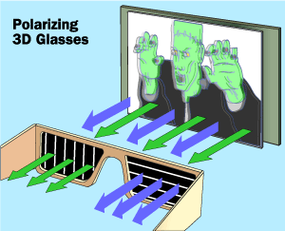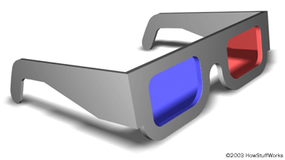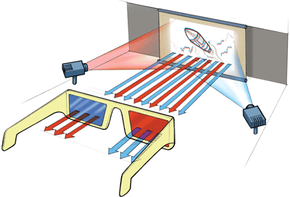3-D Viewing
In a movie theater, the reason why you wear 3-D glasses is to feed different images into your eyes just like a View-Master does. The screen actually displays two images, and the glasses cause one of the images to enter one eye and the other to enter the other eye. There are two common systems for doing this:
Red/Green or Red/Blue
Although the red/green or red/blue system is now mainly used for television 3-D effects, and was used in many older 3-D movies. In this system, two images are displayed on the screen, one in red and the other in blue (or green). The filters on the glasses allow only one image to enter each eye, and your brain does the rest. You cannot really have a color movie when you are using color to provide the separation, so the image quality is not nearly as good as with the polarized system.
Advertisement
Polarization
At Disney World, Universal Studios and other 3-D venues, the preferred method uses polarized lenses because they allow color viewing. Two synchronized projectors project two respective views onto the screen, each with a different polarization. The glasses allow only one of the images into each eye because they contain lenses with different polarization.

There are some more complicated systems as well, but because they are expensive they are not as widely used. For example, in one system, a TV screen displays the two images alternating one right after the other. Special LCD glasses block the view of one eye and then the other in rapid succession. This system allows color viewing on a normal TV, but requires you to buy special equipment.

For more information on 3-D glasses and related topics, check out the links below.
Related HowStuffWorks Articles
More Great Links
- Demonstrations For Use With Blue/Red 3-D Glasses
- Stereoscopy: Where Did It Come From? Where Will It Lead?
- Stereoscopic viewing
- Perception and Illusion Exhibits
